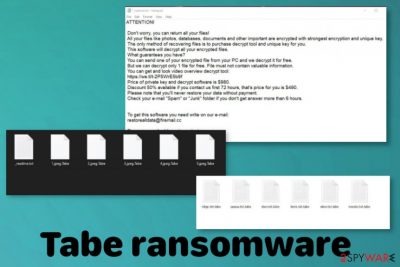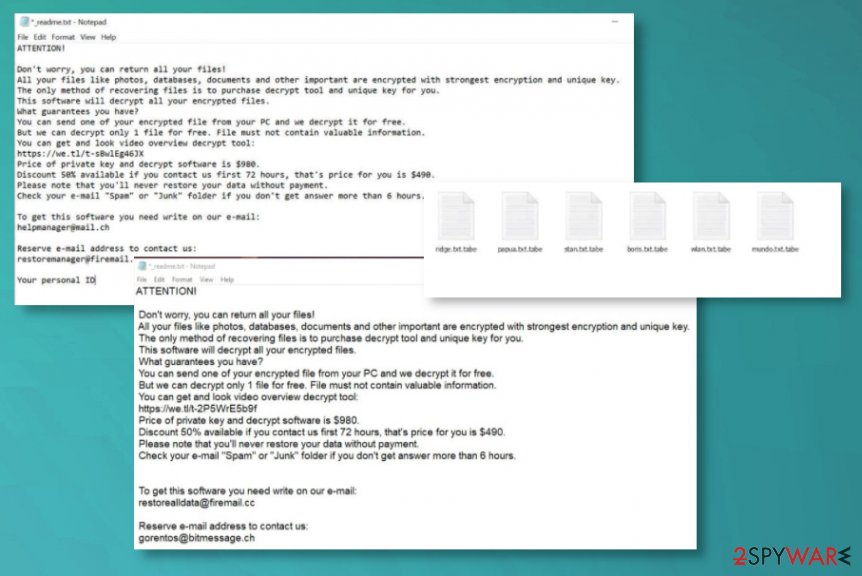Tabe ransomware (Virus Removal Guide) - Decryption Methods Included
Tabe virus Removal Guide
What is Tabe ransomware?
Tabe ransomware is the threat that belongs to a well-known ransomware family and comes as a 234th version

Unfortunately, Tabe ransomware virus is one of many versions already because creators do exactly that. Previously this family was decryptable because versions used offline keys that allowed malware experts to release the decryption tool. However, for almost a year these threats rely on online IDs and cannot be decrypted with any tool. Malware analysists[1] have no other options put to report about new campaigns and variants that come out pretty much weekly.
The particular Tabe virus is one of the newest versions, but all the features remain unchanged since last year pretty much because helpmanager@mail.ch is the same contact email that appears in the _readme.txt ransom note that also reveals $980/$490 as the amount of money in cryptocurrency that is wanted from people. This text file reveals all the needed details about the encryption process and informs people about possible steps from there. Nevertheless, there is no reason to pay the demanded amount because there are only a few incidents when malicious actors recovered files for victims. In most cases, people behind the virus remain silent and gather money without any feedback.[2]
| Name | Tabe ransomware |
|---|---|
| Family | Djvu ransomware virus |
| File marker | .tabe is the particular file extension that indicates which data is affected on the system. It comes after the original name and file-type appendix, so the name remains the same even after the encryption, but the file is unopenable |
| Ransom note | _readme.txt is the file that gets added on the desktop and in other folders that contain encrypted files. This is the direct message from malicious actors who demand payments for alleged decryption |
| Ransom amount | $980/$490 in cryptocurrency. It depends on how quickly you can contact these actors |
| Danger | Cryptocurrency-extortion based threats are dangerous because these viruses involve blackmailing messages and full system control. Anything related to these activities and malicious actors can lead to permanent data or even money losses |
| Distribution | This virus family is known for spreading malware via pirating sites, torrent platforms, and other malicious sources online |
| Contact information | helpmanager@mail.ch and restoremanager@firemail.cc |
| Removal | You need to use proper anti-malware tools when you want to completely remove Tabe ransomware. Such tools can find[3] and eliminate any threats related to the infection |
| System repair | The system gets affected behind your back, you can't use particular functions. This is why we recommend running FortectIntego for the purpose of finding and fixing issues regarding the affected files and functions |
Tabe ransomware virus is an infection that is not related to scammers. People behind such complex threats are focused on getting your money and damaging the machine further. Criminals release this file-encrypting infection and restrict the access to your files, like documents, images, videos, archives. Once that is done and you see the .tabe added at the end of the file name, you can be sure that the main part of the malware changes got done.
Since Tabe ransomware uses a powerful encryption algorithm it can quickly go through various files and encode them. This is how the malware makes users eager to pay the ransom amount. When the original code of the data is altered, you can't even open the file and recover it. However, paying is not the best option for such infections.
Tabe ransomware releases a ransom note that states all the facts about encryption processes and the _readme.txt file reads the following:
ATTENTION!
Don’t worry, you can return all your files!
All your files like photos, databases, documents and other important are encrypted with strongest encryption and unique key.
The only method of recovering files is to purchase decrypt tool and unique key for you.
This software will decrypt all your encrypted files.
What guarantees you have?
You can send one of your encrypted file from your PC and we decrypt it for free.
But we can decrypt only 1 file for free. File must not contain valuable information.
You can get and look video overview decrypt tool:
https://we.tl/t-sBwlEg46JX
Price of private key and decrypt software is $980.
Discount 50% available if you contact us first 72 hours, that’s price for you is $490.
Please note that you’ll never restore your data without payment.
Check your e-mail “Spam” or “Junk” folder if you don’t get answer more than 6 hours.To get this software you need write on our e-mail:
helpmanager@mail.chReserve e-mail address to contact us:
restoremanager@firemail.ccYour personal ID
Even though these claims are scary and believable, paying the Tabe ransomware creates is not the solution. You cannot be sure that your files will get restored easily since criminals are focused on getting your money and creating damage permanently. However, there are some solutions to these ransomware infections. Decryption is no longer possible since the tool that was useable previously is no longer supported, but you can recover some of the encrypted files using system functions and thrid-party tools.

File recovery after .tabe files virus attack
You need to note that this is the version of the Djvu virus family that cannot be easily decrypted since it uses online IDs for the most part. Online keys mean that each Tabe virus infection happens when ransomware connects to the remote server that is controlled by attackers.
This is how the malware can form those extensions that appear after the encryption. Each of them is unique for the particular victim and cannot be found in the wild unless the database is breached. Tabe ransomware indicates affected files, even though files that get encrypted are the majority of the commonly used data.
To remover those files to a primary stage, you need to fully remove Tabe ransomware and clean the machine. Unfortunately, there are no tools that could do both. Anti-malware programs can clear the virus and remove all the associated programs from the OS, so your device is no longer affected by the threat.
However, tools that work for Tabe ransomware removal are not the ones that could repair the damage or restore encrypted files. You need to repair system functions because many of them get disabled by the ransomware to ensure that the victim has fewer options for the data recovery. You can find, indicate, and repair files affected by the malware using FortectIntego.
When you are sure that all the files got repaired and corrupted programs can run, you can rely on your backup files, data stored on the external devices, or could service and replace encrypted data with files that haven't got affected by the thread. Tabe ransomware can renew its activities if you do not remove all traces completely, so make sure to double-check to avoid permanent damage and losses. Rely on additional tips down below if you need some help.

Pirating leads to issues with your important files
Remember that ransomware is a complex threat that can affect many functions and different parts of the system once it infects the system. However, these distribution ways also can differ from family to family and be stealthy or obvious. Nevertheless, ransomware has the name of a most dangerous infection for a reason.
The main method of the distribution involves malicious files, mainly executables or macro-filled MS documents. You can receive emails from suspicious senders and open the attachment without thinking. But such behavior leads to triggering the infection.
People also tend to look for cheatcodes, cracks, and other files found on pirating ant torrent services. It is particularly known that NBA game cheats, Adobe cracks, other software licensed keys are spreading ransomware on various systems via the internet. You need to pay attention to such details and stay away from any illegal or at least potentially dangerous activities.
Make sure to clear any traces of .tabe virus, so you can recover files safely
There is no easy way to remove Tabe ransomware because this threat is one of the more persistent among other malware types. Malicious actors responsible for the distribution and coding of such threats can install scripts and even alter functions to keep ransomware-related processes running.
Besides the Tabe ransomware virus, your machine can have other malware that gathers, damages data, or even spies on you. You need proper security software like SpyHunter 5Combo Cleaner or Malwarebytes, anti-malware tools that can find and terminate all parts of the shady infection. Get a tool that you can trust and run the full check on the affected system.
Unfortunately, Tabe ransomware removal is not the process that could remover files for you. You can terminate the threat, remove traces of the infection, and then repair system functions, damaged files with FortectIntego or another PC repair, system optimization. This is a crucial step before you even attempt the file recovery because any function needed for file restoring can be disabled or corrupted by the malware.
Getting rid of Tabe virus. Follow these steps
Manual removal using Safe Mode
To remove the Tabe ransomware virus completely, you may need to reboot the PC in Safe Mode with Networking, so the AV tool can properly run on the system
Important! →
Manual removal guide might be too complicated for regular computer users. It requires advanced IT knowledge to be performed correctly (if vital system files are removed or damaged, it might result in full Windows compromise), and it also might take hours to complete. Therefore, we highly advise using the automatic method provided above instead.
Step 1. Access Safe Mode with Networking
Manual malware removal should be best performed in the Safe Mode environment.
Windows 7 / Vista / XP
- Click Start > Shutdown > Restart > OK.
- When your computer becomes active, start pressing F8 button (if that does not work, try F2, F12, Del, etc. – it all depends on your motherboard model) multiple times until you see the Advanced Boot Options window.
- Select Safe Mode with Networking from the list.

Windows 10 / Windows 8
- Right-click on Start button and select Settings.

- Scroll down to pick Update & Security.

- On the left side of the window, pick Recovery.
- Now scroll down to find Advanced Startup section.
- Click Restart now.

- Select Troubleshoot.

- Go to Advanced options.

- Select Startup Settings.

- Press Restart.
- Now press 5 or click 5) Enable Safe Mode with Networking.

Step 2. Shut down suspicious processes
Windows Task Manager is a useful tool that shows all the processes running in the background. If malware is running a process, you need to shut it down:
- Press Ctrl + Shift + Esc on your keyboard to open Windows Task Manager.
- Click on More details.

- Scroll down to Background processes section, and look for anything suspicious.
- Right-click and select Open file location.

- Go back to the process, right-click and pick End Task.

- Delete the contents of the malicious folder.
Step 3. Check program Startup
- Press Ctrl + Shift + Esc on your keyboard to open Windows Task Manager.
- Go to Startup tab.
- Right-click on the suspicious program and pick Disable.

Step 4. Delete virus files
Malware-related files can be found in various places within your computer. Here are instructions that could help you find them:
- Type in Disk Cleanup in Windows search and press Enter.

- Select the drive you want to clean (C: is your main drive by default and is likely to be the one that has malicious files in).
- Scroll through the Files to delete list and select the following:
Temporary Internet Files
Downloads
Recycle Bin
Temporary files - Pick Clean up system files.

- You can also look for other malicious files hidden in the following folders (type these entries in Windows Search and press Enter):
%AppData%
%LocalAppData%
%ProgramData%
%WinDir%
After you are finished, reboot the PC in normal mode.
Remove Tabe using System Restore
System Restore feature can also help with the removal procedures because it recovers the OS in a previous state without the Tabe virus damage
-
Step 1: Reboot your computer to Safe Mode with Command Prompt
Windows 7 / Vista / XP- Click Start → Shutdown → Restart → OK.
- When your computer becomes active, start pressing F8 multiple times until you see the Advanced Boot Options window.
-
Select Command Prompt from the list

Windows 10 / Windows 8- Press the Power button at the Windows login screen. Now press and hold Shift, which is on your keyboard, and click Restart..
- Now select Troubleshoot → Advanced options → Startup Settings and finally press Restart.
-
Once your computer becomes active, select Enable Safe Mode with Command Prompt in Startup Settings window.

-
Step 2: Restore your system files and settings
-
Once the Command Prompt window shows up, enter cd restore and click Enter.

-
Now type rstrui.exe and press Enter again..

-
When a new window shows up, click Next and select your restore point that is prior the infiltration of Tabe. After doing that, click Next.


-
Now click Yes to start system restore.

-
Once the Command Prompt window shows up, enter cd restore and click Enter.
Bonus: Recover your data
Guide which is presented above is supposed to help you remove Tabe from your computer. To recover your encrypted files, we recommend using a detailed guide prepared by 2-spyware.com security experts.If your files are encrypted by Tabe, you can use several methods to restore them:
Data Recovery Pro is the tool that can by an alternate version for file backups
You should note that data backups are important. If you do not have all the files backed up, you can use this option
- Download Data Recovery Pro;
- Follow the steps of Data Recovery Setup and install the program on your computer;
- Launch it and scan your computer for files encrypted by Tabe ransomware;
- Restore them.
Windows Previous Versions for the affected files
When you enable the System restore function on the machine, you can rely on the Windows Previous Versions feature for file recovery after Tabe ransomware attack
- Find an encrypted file you need to restore and right-click on it;
- Select “Properties” and go to “Previous versions” tab;
- Here, check each of available copies of the file in “Folder versions”. You should select the version you want to recover and click “Restore”.
ShadowExplorer is the option for files affected by the Tabe ransomware virus
When you are sure that Tabe virus is not affecting Shadow Volume Copies, you can rely on ShadowExplorer and restore those encrypted files easily
- Download Shadow Explorer (http://shadowexplorer.com/);
- Follow a Shadow Explorer Setup Wizard and install this application on your computer;
- Launch the program and go through the drop down menu on the top left corner to select the disk of your encrypted data. Check what folders are there;
- Right-click on the folder you want to restore and select “Export”. You can also select where you want it to be stored.
Tabe ransomware decrypted is not released, but Djvu files decryption tool might help
Tabe ransomware is the version that uses online iDs, of you have encountered the version of this family that relies on offline keys, you can rely on Emsisoft DJVU decrypter
Finally, you should always think about the protection of crypto-ransomwares. In order to protect your computer from Tabe and other ransomwares, use a reputable anti-spyware, such as FortectIntego, SpyHunter 5Combo Cleaner or Malwarebytes
How to prevent from getting ransomware
Do not let government spy on you
The government has many issues in regards to tracking users' data and spying on citizens, so you should take this into consideration and learn more about shady information gathering practices. Avoid any unwanted government tracking or spying by going totally anonymous on the internet.
You can choose a different location when you go online and access any material you want without particular content restrictions. You can easily enjoy internet connection without any risks of being hacked by using Private Internet Access VPN.
Control the information that can be accessed by government any other unwanted party and surf online without being spied on. Even if you are not involved in illegal activities or trust your selection of services, platforms, be suspicious for your own security and take precautionary measures by using the VPN service.
Backup files for the later use, in case of the malware attack
Computer users can suffer from data losses due to cyber infections or their own faulty doings. Ransomware can encrypt and hold files hostage, while unforeseen power cuts might cause a loss of important documents. If you have proper up-to-date backups, you can easily recover after such an incident and get back to work. It is also equally important to update backups on a regular basis so that the newest information remains intact – you can set this process to be performed automatically.
When you have the previous version of every important document or project you can avoid frustration and breakdowns. It comes in handy when malware strikes out of nowhere. Use Data Recovery Pro for the data restoration process.
- ^ Michael Gillespie. Ransomware report. Twitter. Social media platform.
- ^ Doug Olenick. Ransomware: To pay or not to pay. SC-magazine. Security news.
- ^ Tabe virus detection. Virustotal. Online malware scanner.





















